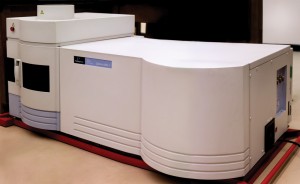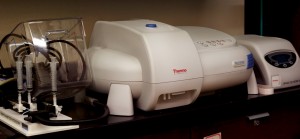Science Department receives new instrument for chemistry lab

The new spectrometer will be installed in late fall following modifications to the lab. The instrument is roughly 5 feet long, 3 feet tall, and weighs about 500 lbs.
The Newman University Science Department recently received a donation of an instrument to help chemistry students learn industry standards for research.
The instrument, a Perkin-Elmer Inductively Coupled Plasma Optical Emission Spectrophotometer (ICP-OES), will be installed in November, once modifications have been made to the lab.
The spectrometer, as these types of instruments are commonly referred to, is used to measure the concentration of various metals such as lead, iron, chromium or aluminum in materials such as groundwater, soils and sludge. Students will use the instrument on research projects, including measuring the levels of chromium, arsenic and lead in cosmetics.
“This instrument aspirates liquid samples into a very excited gas called a plasma,” said John Sander, vice president of technology at Lubrication Engineers of Wichita, the firm that donated the instrument to Newman. “The temperature of the plasma is in the range of the temperature at the surface of the sun. The electrons within the atoms of the materials present in the sample are excited to an elevated state. As they drop back to their preferred ground state they emit energy in the form of light that is representative of each specific element present in the sample.”
The instrument has the ability to measure the content of elemental metals to parts-per-billion levels. Sander said Lubrication Engineers upgrades their spectrometers every 8 to 10 years and it was time for the ICP-OES to be upgraded. Company officials decided to donate it rather than throw it away.
“The ICP is still in very good operating condition, and we didn’t really want to send a working instrument to the landfill,” Sander said.
Sander is a lector at a church also attended by Renee Hein, Ph.D., a 2002 alumna and former assistant professor of chemistry at Newman. When Sander asked Hein if there would be any interest by Newman in the ICP, she put Sander in contact with the Science Department.
“This is a type of instrument that many companies have,” Hein said. “Students who graduate with a chemistry degree need to have experience with as many common instruments as possible.”
– Robin Allard ‘14


